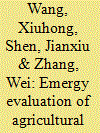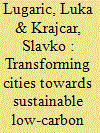|
|
|
Sort Order |
|
|
|
Items / Page
|
|
|
|
|
|
|
| Srl | Item |
| 1 |
ID:
110432


|
|
|
|
|
| Publication |
2011.
|
| Summary/Abstract |
Cerrado, a savannah region, is Brazil's second largest ecosystem after the Amazon rainforest and is also threatened with imminent destruction. In the present study emergy synthesis was applied to assess the environmental performance of a coffee farm located in Coromandel, Minas Gerais, in the Brazilian Cerrado. The effects of land use on sustainability were evaluated by comparing the emergy indices along ten years in order to assess the energy flows driving the production process, and to determine the best production model combining productivity and environmental performance. The emergy indices are presented as a function of the annual crop. Results show that Santo Inácio farm should produce approximately 20 bags of green coffee per hectare to accomplish its best performance regarding both the production efficiency and the environment. The evaluation of coffee trade complements those obtained by contrasting productivity and environmental performance, and despite of the market prices variation, the optimum interval for Santo Inácio's farm is between 10 and 25 coffee bags/ha.
|
|
|
|
|
|
|
|
|
|
|
|
|
|
|
|
| 2 |
ID:
125447


|
|
|
|
|
| Publication |
2013.
|
| Summary/Abstract |
The evaluation of ecosystem health in urban clusters will help establish effective management that promotes sustainable regional development. To standardize the application of emergy synthesis and set pair analysis (EM-SPA) in ecosystem health assessment, a procedure for using EM-SPA models was established in this paper by combining the ability of emergy synthesis to reflect health status from a biophysical perspective with the ability of set pair analysis to describe extensive relationships among different variables. Based on the EM-SPA model, the relative health levels of selected urban clusters and their related ecosystem health patterns were characterized. The health states of three typical Chinese urban clusters - Jing-Jin-Tang, Yangtze River Delta, and Pearl River Delta - were investigated using the model. The results showed that the health status of the Pearl River Delta was relatively good; the health for the Yangtze River Delta was poor. As for the specific health characteristics, the Pearl River Delta and Yangtze River Delta urban clusters were relatively strong in Vigor, Resilience, and Urban ecosystem service function maintenance, while the Jing-Jin-Tang was relatively strong in organizational structure and environmental impact. Guidelines for managing these different urban clusters were put forward based on the analysis of the results of this study.
|
|
|
|
|
|
|
|
|
|
|
|
|
|
|
|
| 3 |
ID:
128382


|
|
|
|
|
| Publication |
2014.
|
| Summary/Abstract |
China's grain-for-green policy (GFGP) was implemented with the goal of improving ecological security. Consequently, agricultural energy and agrochemical inputs have been significantly increased to improve food security and to increase the income of farmers in the regions where the GFGP was implemented. In analysis of the sustainability of the agricultural system affected by the GFGP, it is essential to consider both economic profitability and environmental sustainability. Using Yanchi County as a case study area, this study used an emergy synthesis to examine the sustainability of the agricultural system before and after the GFGP in Northwest China. We found that the total emergy input and energy output of the agricultural system in the study area increased from 1991 to 2008; however, the sustainability of the system declined, and this decline was especially evident after the GFGP was launched in 2001. Increasing inputs of non-renewable purchased resources will not only reduce the effectiveness of the GFGP in Northwest China, but also hinder the implementation of the energy-saving and emission-reduction policy that China launched in 2005. We suggest that sustainable agricultural development in Northwest China should be based on effective use of renewable resources and development of a low-carbon agricultural economy.
|
|
|
|
|
|
|
|
|
|
|
|
|
|
|
|
| 4 |
ID:
128440


|
|
|
|
|
| Publication |
2014.
|
| Summary/Abstract |
The evaluation of natural capital and environmental services has always been an important step in the implementation of sustainable development concepts and policies. The results presented in this study address the demand for environmental support of the economy of Xilinguole League in the Inner Mongolia Autonomous Region as well as the value of its natural and human-made capital. The results show that the reliance of the economy of Xilinguole League on local and imported non-renewable resources (coal and minerals) decreases both the environmental and economic sustainability of the area. Emergy-based performance indicators of the Xilinguole League economy show a low sustainability index (ESI=0.79), though it is higher than for the Chinese economy as a whole (ESI=0.47), as well as a low percentage of renewable resources being used (%REN=0.16, though this is higher than for all of China, 0.09). In contrast, the grassland-based livestock sector shows a higher renewability index (%REN=0.67) and sustainability (ESI=9.61). The emergy exchange ratios (exported emergy/imported emergy) are calculated to be 4.38 for the livestock system and 4.28 for the Xilinguole economy, which is much higher than the value of 1.74 for the overall Chinese economy, indicating uncompensated overexploitation of local systems (meat and coal, respectively). Intensified coal exploitation and intensive cattle grazing are discussed to support the decision-making process for setting local energy policy and ecological compensation. It is proposed that conservation of coal resources (avoiding misuse and moderating excess extraction and trade) and protection of natural grassland capital are more advantageous in emergy terms than the "blind" pursuit of accelerated, economic growth.
|
|
|
|
|
|
|
|
|
|
|
|
|
|
|
|
| 5 |
ID:
119798


|
|
|
|
|
| Publication |
2013.
|
| Summary/Abstract |
The economy of China keeps increasing at high rate, although a bit slower recently than in the past due to the international economic turmoil. The Chinese economic performance affects the world economy in many ways (from increased primary resource and commodity imports to a more active financial role of China worldwide). Not unexpectedly, several and diverse environmental problems are coupled with economic growth, linked to resource availability, competition for energy resources and the overall carrying capacity of the environment as a source and a sink. Monodimensional assessments of either economic growth or environmental aspects are unlikely to provide the needed understanding of development opportunities and potential environmental loading. We suggest in this paper an assessment of the evolution of Chinese Economy based on the Emergy Accounting method, developed by H.T. Odum in the Eighties and further refined more recently. The emergy approach is being increasingly applied worldwide, and in China as well, to study individual production processes, sectors and whole economies and provides a comprehensive picture of the interaction of economic growth and the environment, much useful for economic and environmental policy making. A set of emergy-based performance indicators was calculated with reference to the year 2009 and compared with previous studies from literature, by means of a standardization procedure to ensure consistency. The 2009 national Emergy/GDP ratio, an indicator of the emergy investment per unit of economic product generated, has been calculated respectively as 8.61E+11 solar equivalent joules/Yuan RMB (equivalent to 5.88E+12 sej/US$), showing a decreasing trend from 1975 up-to-date, similar to other countries over their development path. The Emergy Sustainability Index (ESI), an aggregate measure of economic performance and environmental load, also shows a decreasing trend signaling that the Chinese economic development is strictly coupled to non-negligible environmental stress and lower sustainability.
|
|
|
|
|
|
|
|
|
|
|
|
|
|
|
|
| 6 |
ID:
096130


|
|
|
|
|
| Publication |
2010.
|
| Summary/Abstract |
The present study comprehensively reviews emergy analysis and performance evaluation of biomass energy. Biomass resources utilization technologies include (a) bioethanol production, (b) biomass for bio-oil, (c) biodiesel production, (d) straw as fuel in district heating plants, (e) electricity from Municipal Solid Waste (MSW) incineration power plant, (f) electricity from waste landfill gas. Systems diagrams of biomass, which are to conduct a critical inventory of processes, storage, and flows that are important to the system under consideration and are therefore necessary to evaluate, for biomasses are given. Emergy indicators, such as percent renewable (PR), emergy yield ratio (EYR), environmental load ratio (ELR) and environmental sustainability index (ESI) are shown to evaluate the environmental load and local sustainability of the biomass energy. The emergy indicators show that bio-fuels from crop are not sustainable and waste management for fuels provides an emergy recovery even lower than mining fossil fuel.
|
|
|
|
|
|
|
|
|
|
|
|
|
|
|
|
| 7 |
ID:
111452


|
|
|
|
|
| Publication |
2012.
|
| Summary/Abstract |
Sustainability involves aspects of society, economy, and environment. Environmental sustainability is one of the most important factors to support global energy consumption and to absorb the pollution generated by human activities. Because emergy can be used to measure both money and energy flows in the same units, it provides a way to measure the real wealth of both natural and economic systems and the impact of human activities on these systems. A comparison of the carrying capacity of natural resources with the consumption of these resources at regional or global scales can provide a clear image of sustainability. To assess sustainability around the world, we used the National Environmental Accounting Database data for 102 nations (2008 data) to evaluate the resource consumption by 17 mainstream countries. Our results revealed that most of the countries consumed too many resources, thereby decreasing the overall global sustainability of the natural resources that sustain human society. Our results confirm previous predictions that to ensure long-term sustainability, it will be necessary to control population increases, reduce emergy consumption, and promote emergy efficiency.
|
|
|
|
|
|
|
|
|
|
|
|
|
|
|
|
| 8 |
ID:
094246


|
|
|
|
|
| Publication |
2010, 2010.
|
| Summary/Abstract |
A unified evaluation integrating various forms of energy sources and natural resources, products and services, and imports and exports is carried out systematically at the national scale for the booming Chinese economy 1978-2005, based on the ecological measure of solar emergy. The development of the economy is shown heavily dependent on the consumption of nonrenewable natural resources. Of the total resources use, the indigenous resources contribute the most, along with the increasing imports of nonrenewable resources. The development of the Chinese economy is characterized with the recovery stage during 1978-1981, transformation stage during 1981-1991, steady growth stage during 1991-2000, and accelerated increase stage after 2000, with specific distinctive systems indications.
|
|
|
|
|
|
|
|
|
|
|
|
|
|
|
|
| 9 |
ID:
149914


|
|
|
|
|
| Summary/Abstract |
Recognized as implementation actors of operative measures for transition towards a low carbon economy, cities must establish a development roadmap integrating local resources with local energy development plans. A systematic approach does not exist yet and cities develop their plans individually, which is difficult for small and medium sized cities due to limited development capacities. Conventional city planning approaches do not integrate considerations on energy, economy and environment in transition plans in an easily comparable way, yet making decisions with regards to these parameters is vital to determine outcomes of planned developments on future sustainability of the city.
|
|
|
|
|
|
|
|
|
|
|
|
|
|
|
|
|
|
|
|
|